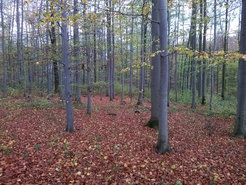When microbes fight over food
You can't see them with the bare eye, but our forest ground is littered with microorganisms. They decompose falling leaves, thereby improving soil quality and counteracting climate change. But how do these single-celled organisms coordinate their tasks? An international research team has has been looking into this little-understood process. The researchers were able to show that, when decomposing foliage, bacteria produce chemical compounds that control their competitors. This competition optimizes the distribution of tasks in the community: only those microorganisms that can fend off other competitors and at the same time are well adapted to the food supply prevail. The results of the study were recently published in Scientific Reports.
Small molecules with big effect

In meadows and forests, the carbon cycle is driven by microbial communities decomposing and utilizing the annually falling leaves. For this, many different steps of decomposition have to be passed through. Different microorganisms can perform similar functions in this process. This concept of functional overlap is based on genetically inherited traits that can become active, but can also remain unused. The active interactions between microorganisms and their food source, as well as among themselves, are mediated by a large number of small molecules. When it rains on the foliage layer in the forest, these molecules mix with natural substances from the environment. The result is a complex mixture known in the earth sciences as dissolved organic matter. Since it also contains molecules of microorganisms, chemical analysis of its composition also provides information about active microbial metabolism. The researchers studied over 6000 organic molecules present in dissolved organic matter from four different foliage species and two different geographical locations.
"Although the exact structure of the individual molecules was still largely unknown to us, we succeeded in grouping them according to their possible origin using a network analysis," explains the study's first author, Dr. Simon Schroeter of the Max Planck Institute for Biogeochemistry. The groups of molecules found this way could then be attributed functions in various metabolic pathways with the help of biochemical databases. Although the microbial communities had similar functions as expected, they adapted to the different foliage within a few days. It seems that task allocation depends less on who can do which function, because that hardly differs, and more on who adapts best to the overall situation while being assertive. "Our studies yield a new view of dissolved organic matter, especially related to its high importance for microbial metabolism," Schroeter continued, "a concept that can be called the meta-metabolome."
Interdisciplinary research as the key to a holistic understanding of environmental processes
When it comes to the question of how microorganisms behave in the presence of certain food offers, the particular challenge is being able to understand the active metabolic processes of the entire microbial community. The genetic makeup of a species alone does not answer this question. In this study, therefore, in addition to DNA sequencing, the composition of proteins and the intermediate and end products of metabolism were analyzed. This revealed that molecular metabolic pathways are also active, leading to the biosynthesis of antibiotics. The release of inhibitory or even lethal antibiotics gives their producers a strong competitive advantage in the competition for food supply. The researchers see this as competition driving the adaptation of the microbial community and optimizing it. The microbial fight over food could therefore be constructive and support those species whose abilities are very well adapted to the food supply.
"Understanding the functioning of microbial communities in the environment holistically is a task that we can only solve in an interdisciplinary way," states the initiator of the study Prof. Dr. Gerd Gleixner. In this context, he refers to the national and international partners of the project, with their different but complementary scientific competences. "The exchange program for young scientists at our graduate school (IMPRS-gBGC) has also helped us enormously," Gleixner adds.
The published results were developed in the DFG-funded Collaborative Research Center (SFB 1076) AquaDiva. Sampling took place at the AquaDiva research station in the Hainich National Park (Thuringia) and at the research station Gut Linde of the Zwillenberg-Tietz Foundation (Brandenburg). In addition to the Max Planck Institute for Biogeochemistry, working groups from the Friedrich Schiller University Jena (Prof. Küsel, Prof. Pohnert), the Helmholtz Centre for Environmental Research (Prof. von Bergen) and the University of Nantes (Prof. Eveillard) were involved in the study.












